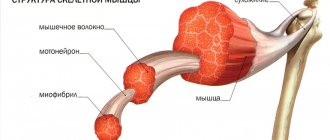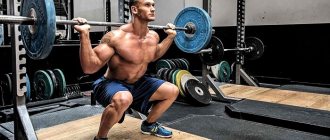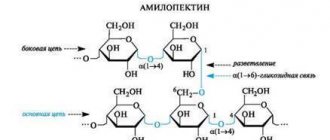How much rest between sets[edit | edit code]
It would seem like an elementary question, to which a clear and unambiguous answer should have been found long ago. However, the optimal duration of rest between approaches (sets) in bodybuilding remains unclear to this day. There are hundreds of articles written on this topic, and each of them has many copies, but very few of them reveal the scientific basis that allows us to understand what factors influence the duration of rest when gaining muscle mass, training for strength or endurance.
First of all, in order to get to the essence of the problem, you need to know the elementary energy processes in the muscles.
To describe it briefly: there are several energy sources in a muscle that are sequentially included in the work. In the first seconds, ATP begins to be consumed, after it is depleted, creatine phosphate begins to be used. It lasts for 30-40 seconds of intense muscular work; in parallel with this process, anaerobic glycolysis begins after 7-10 seconds. Next, glucose begins to be used, which undergoes aerobic glycolysis. When doing bodybuilding, sufficient muscle contraction strength can only be obtained while using creatine phosphate and ATP, then strength indicators decrease so much that continuing the exercise becomes pointless.
Theoretical aspects[edit | edit code]
The complexity of the issue lies in the fact that the mechanisms of muscle growth are still not precisely known.
According to the theory of microtrauma, muscle growth, and therefore an increase in strength, is stimulated by lifting heavy weights, which can only be achieved with fully restored reserves of ATP and creatine phosphate. Therefore, rest between approaches should be at least 2 minutes. The optimal time is 2-3 minutes.
According to the theory of cumulative fatigue, muscle growth is stimulated by the accumulation of muscle waste, primarily lactic acid. In this case, the rest period should be less than 1 minute. The optimal time is 30 seconds - 1 minute.
Currently, most strength programs recommend resting between sets for 2-5 minutes, and programs for increasing muscle mass - from 30 seconds to 1.5 minutes. This is due to a study that showed that a short period of rest caused a greater rise in growth hormone and testosterone levels. However, it was later shown that this does not affect muscle growth. This is most likely due to the short-term effect. In addition, with a short period between sets, the level of the hormone cortisol increases, which inhibits muscle growth.
The situation remained unclear until definitive studies were completed.
New research[edit | edit code]
The above-mentioned theoretical aspects are exaggerated in almost every article, and their inconsistency and mutual exclusivity do not allow us to find a general consensus. Let us turn to the studies that experimentally tried to find out the truth:
- SIMAO, R.; POLITO, M.; MIRANDA, H.; CAMARGO, A.; HOELLER, H.; ELIAS, M.; MAIOR, AS Analysis of different rest intervals between sets in strength training program. Fitness & Performance Journal, v.5, n. 5, p. 290-294, 2006.
Quote from the conclusion:
In this experiment, lasting 1 month, training frequency 3 times a week, the subjects performed strength exercises (biceps curls and bench press), while one group rested 1 minute between sets, and the other 3 minutes. We concluded that there were no significant differences in strength after 4 weeks of training.
- Belmiro Freitas, Simão, Roberto, Miranda, Fabrício, da Silva Novaes, Jefferson, Lemos, Adriana, Willardson, Jeffrey M. Rest Interval between Sets in Strength Training. Sports Medicine: 1 September 2009 – Volume 39 – Issue 9 – pp 765-777
Quote from the conclusion:
Indirect evidence suggests that to improve muscular endurance, the rest period between sets should be shorter than 1 minute. However, a rest period of 3-5 minutes can be considered safer.
- Martim Bottaroa, Breno Martinsb, Paulo Gentila, Dale Wagner. Effects of rest duration between sets of resistance training on acute hormonal responses in trained women. Sports Medicine Australia. Received 24 July 2007 Pages 73-78 (January 2009)
Quote from the conclusion:
The study tested changes in hormone levels (cortisol and growth hormone) after training, depending on the length of rest between sets. One group of athletes took a break of 30 seconds, the second - 60 seconds, and the third - 120 seconds. Immediately after exercise, growth hormone and cortisol levels were higher in the 30-second rest group, but no differences were found in the 1- and 2-minute rest groups. Note: Only 12 well-trained women took part in the study.
- de Souza Jr, TP, Fleck, SJ, Simão, R, Dubas, JP, Pereira, B, de Brito Pacheco, EM, da Silva. Comparison Between constant and decreasing rest intervals: influence on maximum strength and hypertrophy. Journal of Strength & Conditioning Research: July 2010 - Volume 24 - Issue 7 - pp 1843-1850
Quote from the conclusion:
During an 8-week experiment, two groups of athletes performed strength exercises on different muscle groups with different rest periods between sets.
The first group took 2 minute breaks. The second group gradually reduced the rest period from 2 minutes to 30 seconds over 6 weeks. As a result, it was found that in the two groups there are no significant differences in strength indicators and the amount of muscle mass gain, which means that there is no particular importance in the duration of rest between approaches.
- Gentil, P, Bottaro, M, Oliveira, E, Veloso, J, Amorim, N, Saiuri, A, and Wagner, DR. Chronic effects of different between-set rest durations on muscle strength in nonresistance trained young men. J Strength Cond Res 24(1): 37-42, 2010
Quote from the report:
For 12 weeks, untrained students, divided into 2 groups, performed strength exercises of 8-12 repetitions with various rest periods.
The first group rested according to the principle of a work-to-rest ratio of 1 to 3, and the second group - 1 to 6. When summing up the results, it was determined that there were no significant differences in strength indicators between the first and second groups.
Conclusion[edit | edit code]
As the latest research from 2010 showed, the time you spend resting between sets does not affect strength performance and the rate of muscle growth. Therefore, you can rest for as long as you need to fully perform the next exercise or set. So in bodybuilding, the optimal time can be considered 1-3 minutes between approaches. In powerlifting, breaks can be taken longer, until the creatine phosphate depot is completely restored - up to 5-6 minutes. If you want to increase your endurance, keep rest periods shorter than 30 seconds between each set.
conclusions
Let's now highlight the main points from all of the above.
Rest directly depends on which muscle fibers will be involved, for example - fast muscle fibers are included in strength exercises - bench press, deadlift, squats, seated dumbbell press; about 3 minutes of rest are needed to restore them. If slow fibers are included in the work to train strength endurance, that is, exercises are done with low weight and a large number of repetitions, then the rest should be up to 1-2 minutes.
To avoid getting lost, use the diagram below:
1. To develop strength: 1-4 reps/set – rest 3-5 minutes;
2. For muscle growth: 6-8 reps/set – rest 2-3 minutes;
3. For strength endurance: 9-12 repetitions/set – 1-2 minutes;
4. For active fat burning: 13-15 repetitions/set – 0.5 – 1 minute.
Based on your training goals, use the correct rest system, but also additionally use your feelings, what to do during rest, find out in the article - what to do between approaches? After all, it’s not every time you come to training fresh and cheerful, your boss is annoying, you’ve been exhausted by household chores, so combine the recommendations in this article + your feelings and achieve good results, I wish you success










